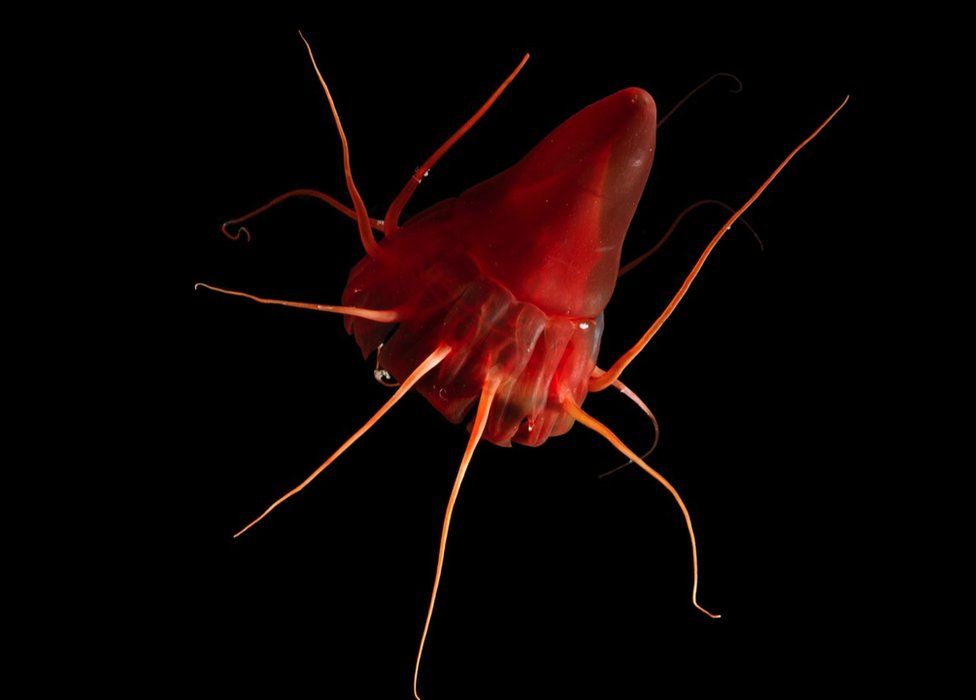ARTICLE AD BOX
 Image source, Vanessa Stenvers
Image source, Vanessa Stenvers
Scientists chose to study a jellyfish species that is 'representative' of many creatures that live in deep water
By Victoria Gill
Science correspondent, BBC News
An experiment to test how seabed mining could affect deep sea life has revealed unexpected impacts on common jellyfish.
There is increasing interest in extracting precious minerals from what are called metallic "nodules" that naturally occur on the seabed.
But marine scientists are concerned about the harm that could be caused.
These researchers studied helmet jellyfish, using special tanks on a research vessel to simulate conditions created by mining activity.
They found that the gelatinous animals were "highly sensitive" to plumes of sediment - a condition created to mimic how mining would stir up seabed deposits.
Image source, V Stenvers
Image caption,The scientists used rotating tanks to simulate sediment circulating in the water
The findings were published in the journal Nature Communications.
Deep-sea mining has been proposed - and opposed - for decades. Mining companies and other supporters say mineral deposits on the seabed can be collected in less environmentally damaging ways than mining on land - and that it could help meet demand for materials for green technologies.
But many marine scientists point out that there will be consequences for marine life that we do not yet understand. Much of the deep ocean is unexplored, so seabed mining opponents also point out that mining activity could cause irreparable damage to ecosystems we do not yet understand.
So far, there has been little research into how it would affect the creatures that live their lives moving and floating through the water column, the vast area between the surface and the seabed. One of the lead researchers on this study, Dr Helena Hauss from the Norwegian research institute Norce told BBC News that this was the impetus behind the new experiment.
"The idea was to get hold of an organism that's globally distributed, and that would be exposed to these conditions in the real world," she explained.
Dark experiments
Because the jellyfish the team studied are so sensitive to light, the scientists worked at night. They captured about 60 animals and put them in temperature-controlled tanks, in a dark lab aboard their research ship.
Marine scientist Vanessa Stenvers, from the Helmholtz Centre for Ocean Research in Kiel, Germany, explained that this simulated the debris that would be disturbed and released by underwater vehicles extracting minerals from the sea floor. "These are rotating tanks," she said. "Essentially re-creating a situation where sediment is disturbed and doesn't settle - it's circulating through the water."
The experiment, which was part of the European iAtlantic project, revealed some unusual effects on the jellyfish: When their bodies became coated in sediment, they produced excessive amounts of a protective mucus. Doing that, the scientists explained, is energetically expensive, so the animals used energy they would otherwise be expending on feeding or movement.
Samples taken from the animals also showed signs of what the researchers called "acute stress" including activation of genes that are associated with wound healing.
Fragile creatures
Helmet jellyfish live throughout the world's oceans - down to depths of several thousand metres.
Image source, Helena Hauss
Image caption,Helmet jellyfish - photographed here in the deep water of Lurefjord in Norway - are found around the world
They have fragile, gelatinous bodies. "That's not true just for jellyfish, but for worms and molluscs - lots of animals that live in the water column," explained Dr Stenvers.
"You can afford to be fragile, because you'll be safe in the in the mid water."
These animals also live in a world of relatively transparent water. One of the dominant forms of communication in the deep sea is bioluminescence, which, the scientists point out, only works in clear water.
Deep-sea mining activity, Dr Stenvers explained, is likely to change the conditions that these animals have evolved in.

 1 year ago
45
1 year ago
45








 English (US) ·
English (US) ·